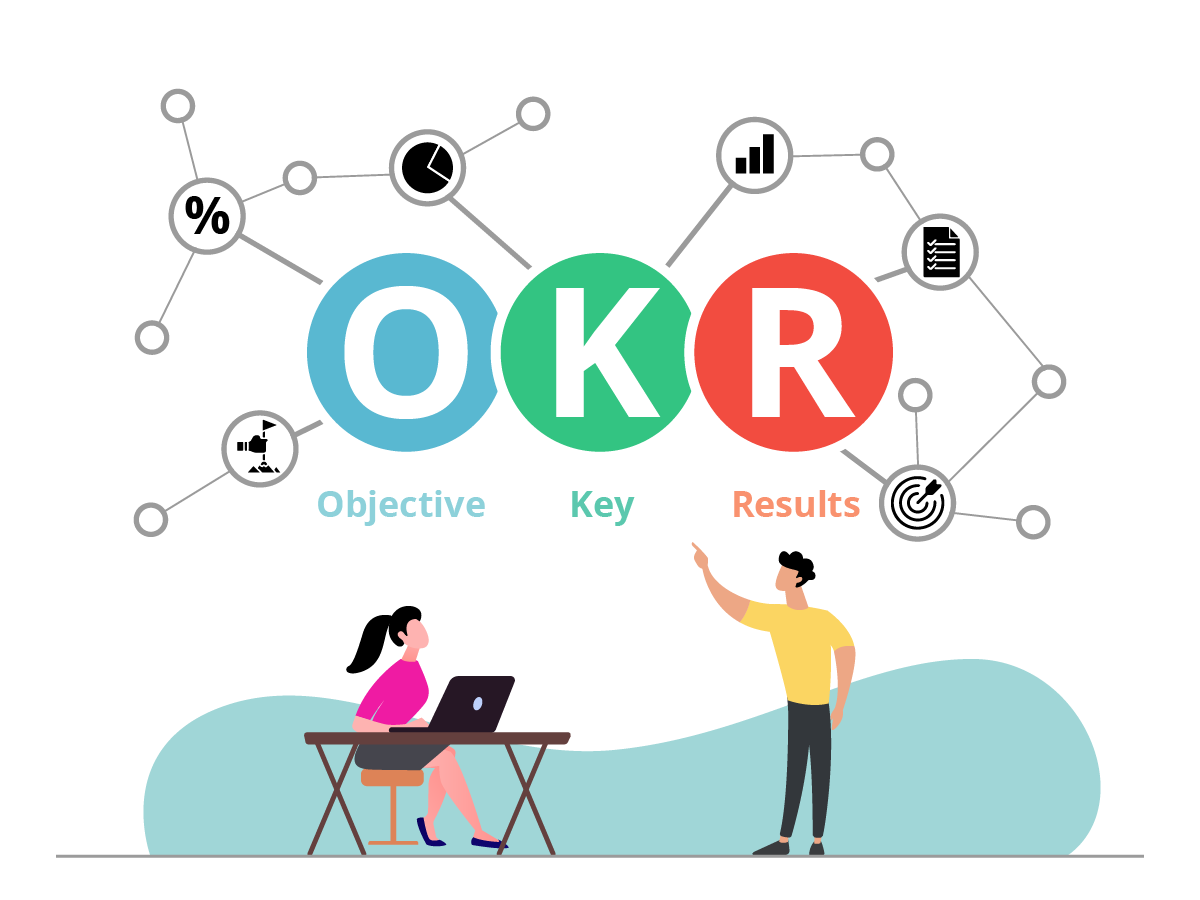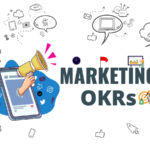
Success in business is often the result of careful planning and goal setting. Defining clear benchmarks for employees helps build unity around a common goal. And, amid this Covid-19 pandemic supporting remote employees focusing on goals and OKRs has become more vital than ever.
Based on Gallup’s research with companies worldwide, only about half of employees strongly agree that they know what is expected of them at work. It is tough for employees to meet performance goals when they don’t know what is expected of them exactly. Thus, the key to bringing long-term success to the company is having a solid goal-setting methodology, where each employee feels connected to business goals and the company’s broader mission. There are several strategies to identify and implement the objectives of the company.
Let’s understand together what is OKR, a little bit of their history, their benefits, how it becomes the path to success.
History of OKR
To understand a little about OKR meaning and how OKRs came to companies around the world, we need to go back TO the history of OKR. Lets look at the 1950s, when Peter Drucker, a manager known as the father of modern management, suggested that giving managers goals would be a wonderful way to run a company. For him, managers should set goals to improve results in a measurable way.
In addition, this data should be periodically verified, acting to encourage continuous improvement in processes. This method was called MBO (Management by Objectives), which large companies widely used at that time, such as HP.
Moving forward a little in the timeline, precisely in 1968, Andrew Grove, CEO of Intel, based on the MBO, implemented a different management model in his company: the IMBO (Intel Management by Objectives). In this method, he upgraded it with the concept of the so-called Key- results, which can be conceptualized as steps or action plans that guide the collaborator towards achieving the established goal. And this is how OKR was born.
Although Intel started the practice, OKR gained fame when Google entered the game!
It all started in 1974 when John Doerr, joined Intel and learned all about OKR management methodology there. Years later, Doerr became an investor in Google and introduced OKR to the company’s founders, Larry Page, and Sergey Brin, who were responsible for implementing OKR at Google.
After being adopted by Google, OKRs have supported the company’s exponential growth, which has grown from 40 employees in 1999 to more than 85,000 today. Given this success, OKRs have become widespread worldwide, proving that both small and large companies can use them, as is already the case with Samsung, Netflix, Airbnb, and many others.
What are OKRs?
As John Doerr himself describes in his book “Measure what matters,” “OKR” is an acronym for Objectives and Key Results. It is a collaborative goal-setting protocol for companies, teams, and individuals. This methodology has a simple yet very effective approach to align the entire organization with strategic objectives and measurable goals. In short, objectives are the activities or deliverables that need to be carried out, and key results are the indicators used to assess whether the company is on track to achieve its objectives.
In the OKR acronym, each letter has a meaning (OKR Meaning) –
“O” is for objectives, which refers to what we want to achieve as a final goal within a period, usually quarterly. These goals should be inspiring, comprehensive, short, engaging, and challenging.
“KR” refers to key results representing how to progress towards the defined objective will be measured. Therefore, they must be measurable and quantitative.
Let’s look at some examples to illustrate these definitions –
To understand OKR, two examples of objectives and key results are given below –
- Objective: Achieve record metrics in all areas of marketing. Term: three months.
- Key Result 1: Exceed 100,000 sessions on the website.
- Key Result 2: Reach 5,000 blog subscriptions.
- Key Result 3: Increase lead generation by 200%.
- Objective: Increase employees’ internal commitment and improve job satisfaction. Term: six months.
- Key Result 1: Ask 25 employees how to improve the work culture.
- Key Result 2: Train all employees to use the OKR system.
- Key Result 3: Develop a plan with 10 actions to improve the level of satisfaction.
As you can see, OKRs can be implemented at different levels, such as company level, team level, and individuals. The key is to communicate them clearly and to have an effective way of tracking their progress.
Benefits of OKR
OKR provides numerous advantages for companies, helping them to achieve success faster, as well as motivating and engaging employees. Here are the main benefits of OKR methodology –
- Team alignment
This is the primary purpose and benefit of OKRs. They connect the teams and the individual goals of the areas in relation to the company’s strategic mission. Managers and the strategic board set OKRs for the entire company (preferably collaborating and synchronizing with the entire team before finalizing them). Based on these, each team sets its own OKRs to help achieve company goals. And based on the team’s goals, everyone sets their own measurable goals. Objectives and key results ensure that everyone is moving in the same direction.
For this, leaders and managers need to invest in good internal communication based on feedback and information exchange, making teams more collaborative. - Focus and agility
With OKRs, it is easier to define the organization’s short-term objectives and follow its performance and key results throughout the implementation of the strategy. In this way, processes are more agile, helping the company strategically focus on priorities. All this contributes to achieving more discipline and agility, thus increasing the organization’s performance. - Employee engagement
Every individual seeks to find opportunities in a challenging company that can bring growth to their professional journey. Therefore, adopting a strategy that works with OKRs can be assertive for employee engagement, as it encourages the participation and involvement of professionals in discussions, planning, and giving feedback.
In addition, it also helps to make employees understand the company’s priorities, thus facilitating teamwork and directing efforts to achieve the organization’s success collectively. Also, in today’s fast-changing business environment, having employee engagement is one of the most important indicators in gauging work satisfaction. According to Gallup Research, only 15% of employees fall in the engaged category. - Autonomy and responsibility
The bottom-up goal-setting approach allows companies to leverage their experience on the front lines of problems to make improvements. Since top management only knows about 4% of frontline problems. This methodology helps to melt the iceberg of ignorance.
A good rule of thumb is that at least 60% of OKRs are set by the team members under the guidance of their managers. With this approach, everyone has personal responsibility towards their goals and is more motivated to achieve them. - Brings transparency
With an OKR tool in companies, the objectives become transparent between top management and the lowest positions in the hierarchy since all teams know the objectives of the others. In an OKR framework, the intern can even see the CEO’s goals, this way everyone in the organization is on the same page, and everyone works together to achieve a common goal.
In addition, this goal-setting framework provides transparency during OKR cycles, as it includes talent in planning and decision-making and clarifies what goals and challenges are faced at each stage.
Guide to OKRs
Even though OKR defined is a practical and straightforward methodology, it is not enough to just define objectives and key results. It is necessary to follow some essential steps responsible for ensuring the proper functioning of this system and facilitating the adhesion and adaptation of employees to the methodology. Here is a comprehensive objectives key results guide –
- Set clear and objective goals
Your OKRs should be well documented, specific, and clear to ensure synchronization. In this way, it is easier to align employees and motivate them to achieve defined goals.
Ideally, OKRs should be neither too easy nor too difficult to achieve. They should be measurable, flexible, and transparent. For example, at Google, any employee can freely consult the OKRs of the company, of any team, of any person. In this way, it gets easier to align employees and motivate them to achieve what has been defined. - Separate goals in top-down and bottom-up approach
As it is a more transparent and inclusive methodology, OKR objectives should not be defined only by the board and passed to the tactical and operational levels as traditional methods. It is essential for managers or business leaders today to involve their employees while setting OKRs. Yes! Being a manager, you can choose to set OKRs for your teams. But, if you do so without their input, they may not feel engaging. Moreover, it is also important to address their concerns, which will eventually help them to achieve the goals better.
The focus is to horizontally involve all the organization’s employees in creating goals, taking advantage of the knowledge of each talent to achieve goals and make the process beneficial for everyone. - Target shorter deadlines
OKR Goals must not be too long, as extended deadlines can distract from the focus. Setting OKRs is a more agile process, so deadlines cannot be too long as it may harm the efficiency of the methodology. You can set time-bound goals, maybe for a week or quarterly, as this will stimulate a sense of urgency to achieve the proposed results without compromising the performance. - Keep track of results
With shorter deadlines, constant monitoring is necessary to ensure the effectiveness of an OKR methodology. For this, you can choose to carry out weekly evaluations to monitor the results obtained, as this helps to identify errors and adjust quickly, without accumulating last-minute actions close to the established deadline.
Moreover, tracking the results allow analyzing and discussing the progress of OKRs and the difficulties encountered, facilitating the development of the following objectives. - Share OKRs with everyone
As we have already mentioned above, one of the benefits of OKR is transparency to ensure the success of an OKR strategy. Therefore, it is recommendable for business leaders and managers to share the organization’s goals and aspirations with all the employees, as well as the results achieved throughout the process.
How to write good OKRs
Let us take a sneak peak on guide to OKRs –
- Set ambitious goals
The first step in writing the OKR method is setting ambitious stretch goals that will challenge employees and push them to surpass themselves. Achieving 100% of the goals when applying the OKR method is not a sign of success instead, it proves that you have been too conservative. The philosophy of the OKRs is to say that it is better to achieve 60% ambitious objectives rather than 100% realistic objectives. For instance, Google does not seek to achieve 100% of its goals; it is satisfied when it reaches a success rate of 60 – 70%.- Add between 3 to 5 key results per objective – Each objective that you set should include between 3 to 5 key results at most. When more than five results are established, the attractive traction is immediately lost, and it gets difficult for employees to focus on all of them. However, you can add as many tasks as you want for each key result. For example –
- Objective : Increase our sales by 50% within the next 3 months.
- Key result 1: Launch marketing acquisition campaigns.
- Define the keywords to target.
- Create 3 landing pages.
- Create campaigns on Google ads.
- Optimize campaigns every 2 days.
- Key result 2 : Contact customers and offer them other products.
- Extract the 30% of most engaged customers from the database.
- Prepare a sequence of 3 emails with a link to the products.
- Send the sequences.
- Key result 3 : Offer a 10% discount on all our products.
- Prepare a sequence of 3 emails offering a discount coupon.
- End the sequence to our entire prospect base.
- Key result 1: Launch marketing acquisition campaigns.
- Objective : Increase our sales by 50% within the next 3 months.
- Add between 3 to 5 key results per objective – Each objective that you set should include between 3 to 5 key results at most. When more than five results are established, the attractive traction is immediately lost, and it gets difficult for employees to focus on all of them. However, you can add as many tasks as you want for each key result. For example –
- Time limit
OKRs should never be set without a target date. The objectives must have a time limit to achieve them. Therefore, a dedicated deadline must be established for employees to achieve the goal satisfactorily. The standard deadline for most OKRs is quarterly.
Difference between OKR and KPI
In the process of performance management, KPI is one of the most used tools for many enterprises. However, with the rise of OKRs, performance management has been given innovative ideas, and in companies like Google and Adobe, OKRs have gradually replaced KPIs (Key Performance Indicators). The emergence of this phenomenon makes everyone think, what is the difference between OKR and KPI? To answer this question, you should first understand what KPIs are?
KPIs are Key Performance Indicators or performance metrics that assess the success of an organization or a given activity. KPIs can apply to projects, action plans, programs, products, and various other initiatives. They can measure the success of anything from sales goals to social media metrics.
We leave you some examples of KPI types –
- Social Media KPIs
- Number of followers
- Scope Engagement
- CTR (Click Through Rate)
- Digital marketing KPIs
- Traffic
- Returning users
- Leads
- Time spent on a web page
- Pageviews
- Duration
One of the main differences between KPIs and OKRs is the intent behind setting goals. KPI targets are usually achievable and represent the product of an existing process or project, while OKR targets are more aggressive and ambitious.
KPIs are important to the strategy. They allow you to decide and communicate your strategic goals for the organization. OKRs, on the other hand, can serve a tactical purpose. They allow you to identify initiatives you want your team to work on and then get them to act.
Pitfalls to avoid while implementing OKR
It is normal to make mistakes when creating and implementing the OKR model. If the creation is not correct from its definition, it leads to a high probability of failure in its implementation. The most common errors are listed below –
- Definition of non-measurable key results
Non-measurable key results OKRs are common mistakes that many people and organizations make when setting up their OKRs. It shows a lack of understanding of the model. When you fail to establish measurable key results to achieve your stated goal, your OKR is nothing more than wishful thinking. - Setting too many OKRs
Do you ever wonder how many OKRs should I have or how many key results per objective? The next most common mistake is setting too many objectives or key results. When it comes to goal-setting, too many OKRs are set, it becomes complex to track and becomes a mere list of achievements. There is a greater chance of success with fewer goals and key results. - Using only a top-down approach
OKRs do not involve any special top-down or other cascading approaches. They are simple goals in which all members of the organization should participate to achieve the goals. - Lack of follow-up
OKRs require active reviews to assess the progress, whether the organization or teams are making toward the stated goal or not! OKR tracking and implementation process discussions are part of the model and are key to an organization’s culture.
Celebrate wins with the whole team
OKR helps companies bridge the gap between goal setting and execution, allowing you to celebrate both short-term and long-term successes.
By now, you must have understood that OKR software boosts teams’ productivity! Being easy to set up, it improves commitment by involving teams in achieving objectives and offering excellent visibility on work progress. So, ready to get started?

